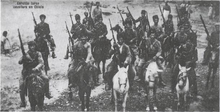the Cape
Federacy of the Cape Restarka do Kabo | |
|---|---|
Motto: Soberania pertes incondicionala a povo! "Sovereignty belongs unconditionally to the people!" | |
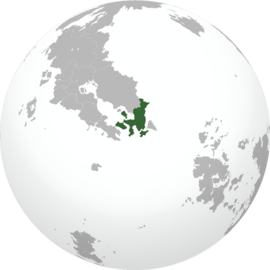 Location of the Cape (dark green) | |
| Capital and largest city | Cape Town |
| Official languages | Cape Coscivian |
| Recognised national languages | Kiravic Coscivian, Cartadanian, Cahokian |
| Government | Federal parliamentary constitutional republic |
• President |
|
| Kil Furey | |
• Marshal of the Stanera | Nancy Pellise |
• Auditor-General | Mitch Whalen |
| Legislature | Supreme National Assembly |
| National Auditorium | |
| National Stanera | |
| Independence from Kiravia and Cartadania | |
• Declaration of the Federacy | October 7, 1891 |
• Occupation of the Cape | May 12, 1938 |
• Republican restoration | October 7, 1951 |
| Population | |
• Estimate | 127,912,766 |
| GDP (nominal) | estimate |
• Total | $4.51 trillion |
• Per capita | $35,544 |
| HDI (2021) | very high |
| Currency | Cape Saer (₴) |
| Driving side | right |
The Cape, officially the Federacy of the Cape, is the easternmost country in Crona. It is bordered on the north, east, and south by the Odeneru and Cathay Oceans. It covers 2.3 million kms2 and has over 127 million people, largely concentrated in its namesake Cape Peninsula. The Cape is a multiethnic and multicultural society, with a majority of the population having mixed ancestry between the country's three primary ethnic groups, Kiravian, Cartadanian, and Cronan. The capital and largest city is Cape Town, which concurrently serves as one of seven provincial capitals.
For thousands of years, the Cape was home to various indigenous peoples. In the 1600s, however, Cartadanian and Kiravian explorers began to settle the country's eastern coast. Their colonies and dominions would expand throughout the 18th and 19th centuries. Disputes over political representation and forced colonial assimilation would lead to the Capetian War of Independence in 1887, led by Melvyn Kalma and the nascent Republican Nationalist Party, which established independence in 1891. The tumultuous young republic, weakened by political violence and rampant power struggles following Kalma's death in 1922, was invaded and occupied by the Kingdom of Palastra during the Great War. A Reclamation war soon took place, re-establishing the republic in 1951. A slow series of reforms throughout the 1980s would transition the state from a one-party military dictatorship to a representative democracy - with the country entering into a rapid period of economic growth and industrialization that continued into the early 21st century.
The Cape today is a federal parliamentary constitutional republic, with a non-executive president serving as head of state and a Prime Executive serving as head of government. Although reforms have disestablished the one-party rule of the Republican Nationalist Party in favour of a nominally multi-party system, the RNP and its Restarkist ideology still dominate the political landscape. The country ranks as a semi-democracy in the Liberty Index and is categorized as an authoritarian democracy. The Cape is a key member of numerous international organizations such as the League of Nations.
The Cape is a regional power with a growing economy and a highly developed market. Traditionally fuelled by the state-led exploitation of natural resources, manufacturing, and international shipping, the economy has grown significantly in its service sector during the past three decades - with no small part due to foreign investment. Cape Town ranks as one of the most economically active and important urban areas in Crona, home to the continent's largest stock and commodity exchanges by market capitalization. The nation has high levels of economic freedom yet maintains numerous state-provided social services, ranking highly on continental indicators of education, health care, and human development.
Etymology
The Cape is named after the Cape Peninsula and its landmark Cape of the Segunda Cabeça. As a great cape, seen as the final waypoint between the Odeneru and the Cathay, sailors, and settlers began to refer to it as simply "the Cape.” The name stuck, and the Kiravian colony that would eventually exist took on the name Axerka Kesta (literally "cape colony"). The Cape is one of a handful of countries in which the definite article is used in its English-language name.
History
Indigenous peoples

It has been accepted that the first humans to settle the lands of the Cape arrived at least 12,000 years ago. Indigenous peoples in the Cape today can trace their ancestry to those groups, the two most significant being the Cahokian and Anahuak peoples.
Throughout history, those Indigenous societies became increasingly complex. By Occidental colonization, many cultures included permanent settlements, hierarchical states, and advanced agricultural techniques. Although it is difficult to estimate the Indigenous population of the Cape at the time of Occidental colonization, the generally accepted number is between 700,000 and 4 million; with the modern Federacy's Executive of Culture recognizing a figure of 2.4 million.
Initial contact between Occidental settlers and the various Indigenous states and commonwealths was relatively peaceful. Those of Indigenous mixed descent played a vital role in establishing Kiravian colonies and trade connections. Indigenous relations with Kiravian Capetians remained strong until independence. However, conflict quickly arose with the Cartadanian settlers, who, starting in the 18th century, began to conquer Indigenous states and attempted to assimilate them into their culture. Such actions reached a peak before the War of Independence, with forced integrations and deportations.
Occidental colonization
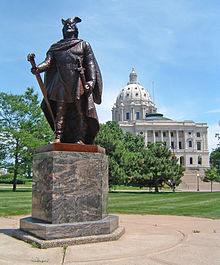
The first documented arrival of Occidentals in the Cape was on Christmas of 1612, by Cartadanian conquistadors. In 1616, Kiravian explorers arrived, erecting a crude effigy of the Marble Emperor on the southern tip of the Cape Peninsula and declaring the establishment of Cape Town. Settlers to the “city” would only truly arrive a decade later. Cartadanian settlers established the permanent settlement of Sao Suro in 1621. These two cities would serve as the heart of the Cape’s fur and gold trades and soon became the respective capitals of Kiravia’s Cape Colony and Cartadania’s Natalia Colony. Skirmishes would break out between the two colonies in the 1670s, culminating in the Great Beaver War, fought over to control the fur trade and the Indigenous states surrounding the colonies.

Fleeing turmoil in the nascent Cartadanian Republic, much of Cartadania’s wealthy left for Natalia. A coup, led by the newly-arrived upper class, took place in 1697 during the republic’s tumultuous Red Year. This coup deposed the former colonial administration for an oligarchic corporate administration. The 17th century would see a de-facto independent Natalia annex the Indigenous statelets surrounding it in the Cahokian Wars; first subjugating, then assimilating the Indigenous people. Such acts came to the chagrin of the new Federative Republic of Cartadania, although any solid police action was found unfeasible by the new Cartadanian Congress.
New arrivals from Kiravia, largely lower-class, peasant farmers and middle-class merchants, settled Cape Colony starting in the 1700s. Throughout the 18th century, Cape Town became an important trading port for the Alshar spice trade and the gateway to Crona's abundant gold, resource, and fur trade. Some of the earliest mixed-race communities developed during that time in Cape Town. Relations between Cape Colony and the surrounding Indigenous peoples were relatively cordial compared to their relations with the Natalia colony. However, they were likewise annexed to halt the growth of the Natalian sphere of influence through the Treaties of 1792, which granted Kiravia control over their foreign policies.
Despite continuous immigration, by the 1870s, only a tiny minority of Cape Colony’s population had been born overseas. Such distance from Great Kirav allowed the development of a unique, Capetian culture and self-governance measures. At the same time, the situation in Natalia became untenable - by the 1880s, the colony’s working-class and Indigenous populations were soon on the brink of open revolution.
Independence and confederation
The Praça da Colônia massacre (1886) in Natalia, where thousands of Indigenous and working-class protestors were shot dead by government forces, prompted the establishment of the National Revolutionary Army (NRA) - whose chapters quickly popped up across both colonies. Under Melvyn Kalma, a prominent advocate for independence and decorated former general in the Kiravian Foreign Legion, a War of Independence was waged starting March of 1887 to overthrow both colonial governments and to unite the peninsula under a new state.
By June of 1887, following major uprisings in Cape Town, Kiravia exited the Cape. The NRA’s provisional government was recognized provided the new state remained a Kiravian ally and allowed the continuation of Kiravian trade. The transition of statehood from Cape Colony to the Capetian Provisional Government was formalized on June 22, 1887. By 1888, Natalia’s Indigenous population was in open revolt, with most local chiefs and leaders pledging allegiance to the NRA. “Liberating the peoples of Natalia” became official policy at the first convocation of the Supreme National Assembly. The invasion of Natalia would conclude in February of 1891. On October 7, the newly formed Federacy of the Cape was declared the successor state to both Cape Colony and Natalia, with Melvyn Kalma serving as the first Prime Executive.

Kalma subsequently introduced many reforms, such as secularizing the state, establishing a period of redress for the Indigenous peoples, and instituting industrializing reforms with the goal of transforming the Cape into a modern, Occidental nation state, governed as a constitutional republic with a secular constitution. To this end, the political activities of the NRA were separated into the civilian Republican Nationalist Party - which was to govern the country under a single-party period of tutelage until such reforms were complete. Following the establishment of the Federacy, certain groups in the former Natalia, both upper and working-class, became discontent with Kalma's reforms. Anti-secularist and anti-tutelage/pro-democracy (the Kadets Rebellion) revolts broke out in 1897 and 1911, respectively, which were suppressed with military force.
20th century
After Kalma’s death in 1922, the reformist-dominated RNP considered the Cape sufficiently developed to exit the period of political tutelage, beginning the first multi-party period of the Federacy of the Cape. Four major parties contested the 1924 elections: the Communist Party, the Constitutional Democrats (Kadets), the Levantine fascist Lusophone Worker’s Front, and the Republican Nationalist Party. The RNP was controversially returned as the majority with a margin of barely one percent - with the months following being permeated with brutal street fighting between Republican, Kadet, Front, and Communist militias. The communist Makhi Anso was
Contemporary era
Politics and government
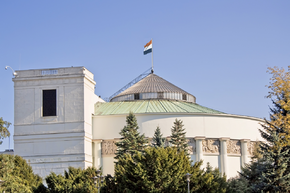
The Federacy of the Cape is a federal parliamentary constitutional republic, comprised of seven provinces in a symmetric federation. The Capetian political system operates under the 1951 Federal Constitution, with the document’s Fundamental Statutes - the articles concerning the republican system, fundamental rights, and the rule of law - held as inviolable.
Since the 1980s, the Cape has been fundamentally structured as a multi-party parliamentary representative democracy. The bicameral Supreme National Assembly, comprised of the 503-member National Stanera and the 28-member National Auditorium, constitutionally holds "all powers of governance". In practice, the Assembly serves serves primarily as the country’s legislature, with executive power wielded by the Office of the Prime Executive, and judicial power wielded by the Supreme Tribunal of the Federacy.
Deputies to the SNA are elected every four years on the principal of universal adult suffrage, who in turn appoint the President of the Federacy, who serves as the head of state and commander-in-chief of the armed forces. The member of the National Stanera who can obtain the confidence of a majority of the lower house is appointed by the President to act as the Prime Executive, who serves as the head of government.
Politics
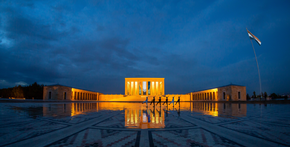
Since the founding of the republic, the dominant political current in Capetian politics has been Restarkism - support for Kalma’s reforms. Restarkism today is manifest as support for a nationalist democracy with a secular constitution and an Occidental, liberal culture. It remains enshrined as the country's constitutional guiding ideology - with the role of its defence given to the armed forces. It likewise serves as the guiding ideology of Kalma's own Republican Nationalist Party, which remains the dominant party in Capetian politics.
Although it is no longer the only legal party and now competes with other parties - namely the Constitutional Democrats, the Humanists - Social Democrats, and the Liberal Democratic Party - on an equal footing, the RNP has continued to rule uninterrupted since democratization. The party continues to leverage the resources it cultivated during the single-party period to remain in power, for example, through its large membership, control of the nation’s largest labour union, and the practising of populism and constant reform expressed through its quadrennial nationwide open primary elections. In the past 30 years, the party has become divided between multiple factions across the political spectrum; each catering to a separate segment of the big-tent.
Law
The supreme law of the Cape is the 1951 Constitution, which establishes a federal republic. Its inviolable Fundamental Statutes guarantee rights and freedoms that cannot be overruled or amended by any government, although a notwithstanding clause (derogatory clause) allows the Supreme National Assembly to unilaterally suspend certain sections of the constitution for up to 6 months.
The nation's judiciary, consisting of the Supreme Tribunal and the Constitutional Court, plays an important role in federal governance. Although subject to the use of the derogatory clause, the Constitutional Court maintains the power to overturn both executive and legislative decisions, while the Supreme Tribunal plays a large role in interpreting legislation and ensuring the constitutionality of politics. Each province nominates one justice to each of the two courts, with their nominations subject to approval by the President of the Federacy.
A common law prevails in all parts of the Cape, with criminal law a responsibility of the federal government and is uniform nationwide. Law enforcement, however, remains the primary responsibility of provincial governments, and is conducted largely by municipal and provincial police forces.
Federal subjects
Internally, the Cape is divided into seven provinces. Although in theory each province is granted wide-reaching authority, power remains heavily centralized with the federal government in the capital of Cape Town. Each province is governed by a parliamentary system similar to that of the federal system.
In increasing order of population, the provinces are:
Foreign relations
Military
Nuclear weapons and the Cape Commission for the Preservation of the Republic
Social issues and human rights
The human rights record of the Cape has been subject to much international condemnation and scrutiny. Particularly, the Cape’s combination of a dominant-party system, a constitutional guiding ideology, and the frequent participation of the armed forces in politics has led to the country’s description as an authoritarian democracy - if not an outright “authoritarian regime”. In 2020, the nation was ranked 16th out of 50 with a score of 6.73 on the Liberty Index, placing it as a hybrid regime. Although Capetians retain strong personal freedoms and civil liberties, the state has been criticized for not having enough democratic attributes and allowing few political rights to its citizens.
Political power remains cemented in the Republican Nationalist Party and the Republican establishment in a system of guided democracy (referred to by the RNP as national democracy, best described by former Prime Executive Jakub Kristuv as a “liberal democracy kept within the boundaries of Restarkist republicanism”. In 2016 and 2022, Supreme Tribunal struck down and dissolved political parties that violated the Constitution’s Restarkist provisions of state secularism; in 2021, the Cape Armed Forces carried out a coup d'état against an unpopular attempt to use the derogatory clause; and the security services-dominated deep state, colloquially referred to as the Republican Guard, has continually remained active even after democratization in assistance of the RNP.
Popular support for the RNP and national democracy, admittedly, remains high - a phenomenon attributed through populist policies, true support for Restarkism, and intra-party democracy that allows for both popular reform and ideological continuity.


